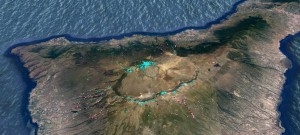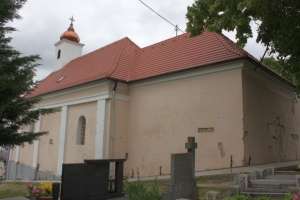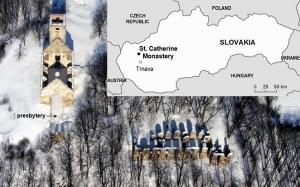Research
Earth Crust and Lithosphere
Research devoted to the structure and properties of the Earth Crust and Lithosphere is based on forward density modeling and integrated modeling of gravity anomalies, geoidal undulations, topographic heights and surface heat flow, on 2D transects or in 3D, making use of all possible geophysical and gelogical constraints such as interpretations of reflection and refraction seismics, geothermics, geomorphology, existing tectonic and geological interpretations. We focus on the Carpatho-Pannonian region.
Inversion Methodology
Research devoted to development of and innovations in methods for solving the gravimetric inverse problem. A so called „Harmonic Inversion Method" has been developed at our department. We were involved in developing the so called „Truncation Filtering Methodology" based on a sequence of systematically varying the truncation parameter in the Stokes convolution integral for the computation of the geoid from gravity anomalies. We participate in enhancing the applicability of a novice and very verstaile inversion methodology, consisting of several steps: removal of a regional trend defined as a 2D harmonic function, vertical separation of signal of sources by triple harmonic continuation procedure, approximation of multiple sources by line segments, non-linear inversion based on local corrections producing contrast contact structural surfaces (interfaces) and/or homogenous 3D star-convex anomalous sources.
Geothermics
Research primarily devoted to modelling of the temperature field of the Western Carpathian's lithosphere and surrounding tectonic units. Development of suitable modeling approaches and numerical procedures for the interpretation of geothermal data in complex geological structures influenced by relatively young tectonic events i.e. solution of both direct and inverse geothermal problems in steady state or transient regime. Prospection of deep geothermal energy sources in Slovakia by means of geothermic methods.
Geodynamics
Research devoted to the study of earth tides and crustal deformations, monitoring and interpretation of extensometric measurements. Special attention is paid to the aperiodic component of the extensometric data with implications to slow tectonic crustal deformations, and to the derivation of rheological properties of the earth crust. We deal also with interpretation of surface deformations and gravity changes observed in active or awakening volcanic areas.
Microgravimetry
Research devoted to interpretation of detailed microgravity surveys with applications in archaeological investigations or geohazards, aiming at detection of shallow cavities such as crypts, hidden rooms and bunkers at historical or cultural sites, or abandoned mine-workings at urban sites. Microgravimetry is combined with georadar wherever possible. Detailed topographic correction, so called building correction, for the effect of building walls and other architectural features is calculated using an in-house program Polygrav that utilizes 3D
Slovak-Italian volcano-gravimetric campaign Etna 2018
Written by Peter Vajda | Published in: Geodynamics |Earth scientists from Slovakia, Pavol Zahorec and Peter Vajda of the department of gravimetry and geodynamics of the ESI SAS and Juraj Papčo of the department of theoretical geodesy of the Slovak University of Technology in Bratislava have teamed up with colleagues from Osservatorio Etneo, Instituto Nazionale di Geofisica e Vulkanologia (INGV) in Catania, Sicilia, Daniele Carbone, Filippo Greco, and Massimo Cantarero to conduct in July a one week campaign of field work devoted to volcano gravimetric measurements. The objective of this effort was to verify in–situ the newly developed methodology devoted to treating deformation–induced gravimetric effects in interpretation of spatio-temporal gravity changes observed and interpreted in volcanic areas that are used to learn as much as possible about magmatic and volcanic processes and to predict volcanic hazard and mitigate damages caused by eruptions or volcanic unrest. A curious by–product of our observations was the determination of the current elevation of Etna, which is a quantity changing in time due to eruptions, using geodetic GNSS (GPS).
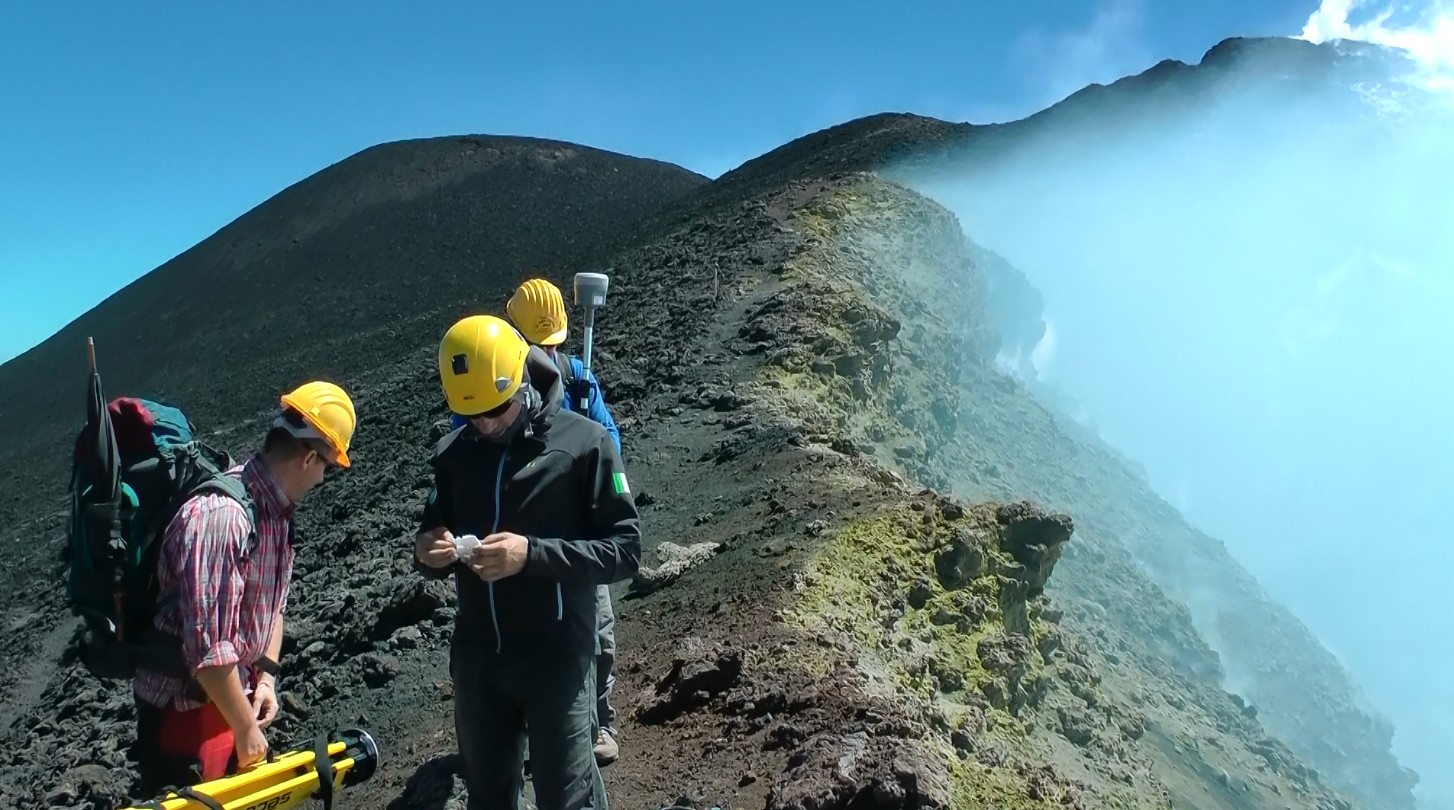
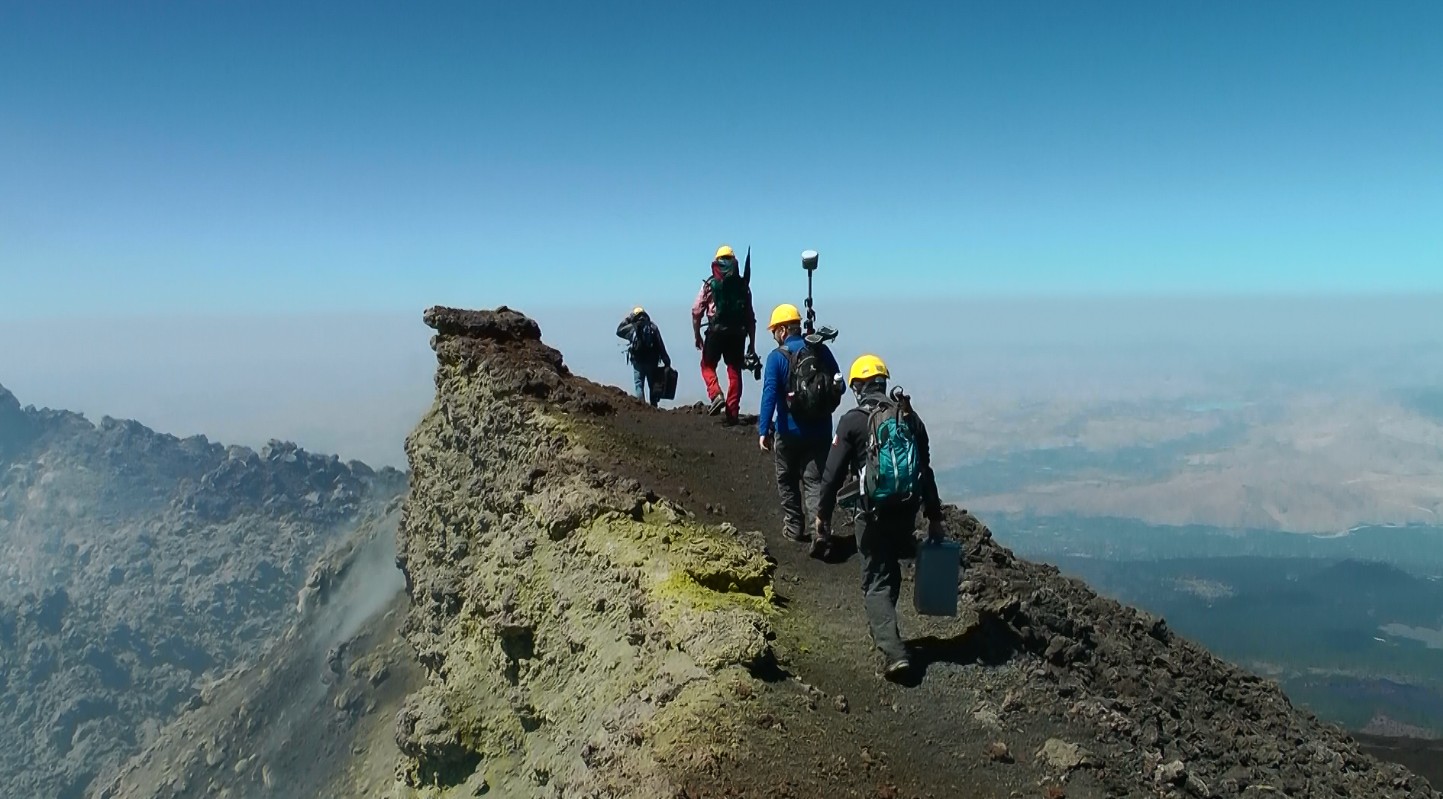
At the edge of the Bocca Nuova crater in the summit area of Etna (ca 3200 m a.s.l.)
Stratovolcano Etna is the largest and highest volcano in continental Europe, belonging to the 3 most active volcanoes in the world. Although it does not belong to the most dangerous volcanoes due its mostly effusive eruptive activity, it is one of the best monitored and studied volcanoes in the world (see web resources below). Volcanologists and geophysicists have learned to recognize spatiotemporal patterns and precursors in the monitored data from extensive networks, continuous and repeat–campaign measurements that are used to gain knowledge about magmatic and volcanic processes, as well as for prediction of volcanic hazards. Part of such data are also spatio-temporal gravity changes. And this is where our research takes part.
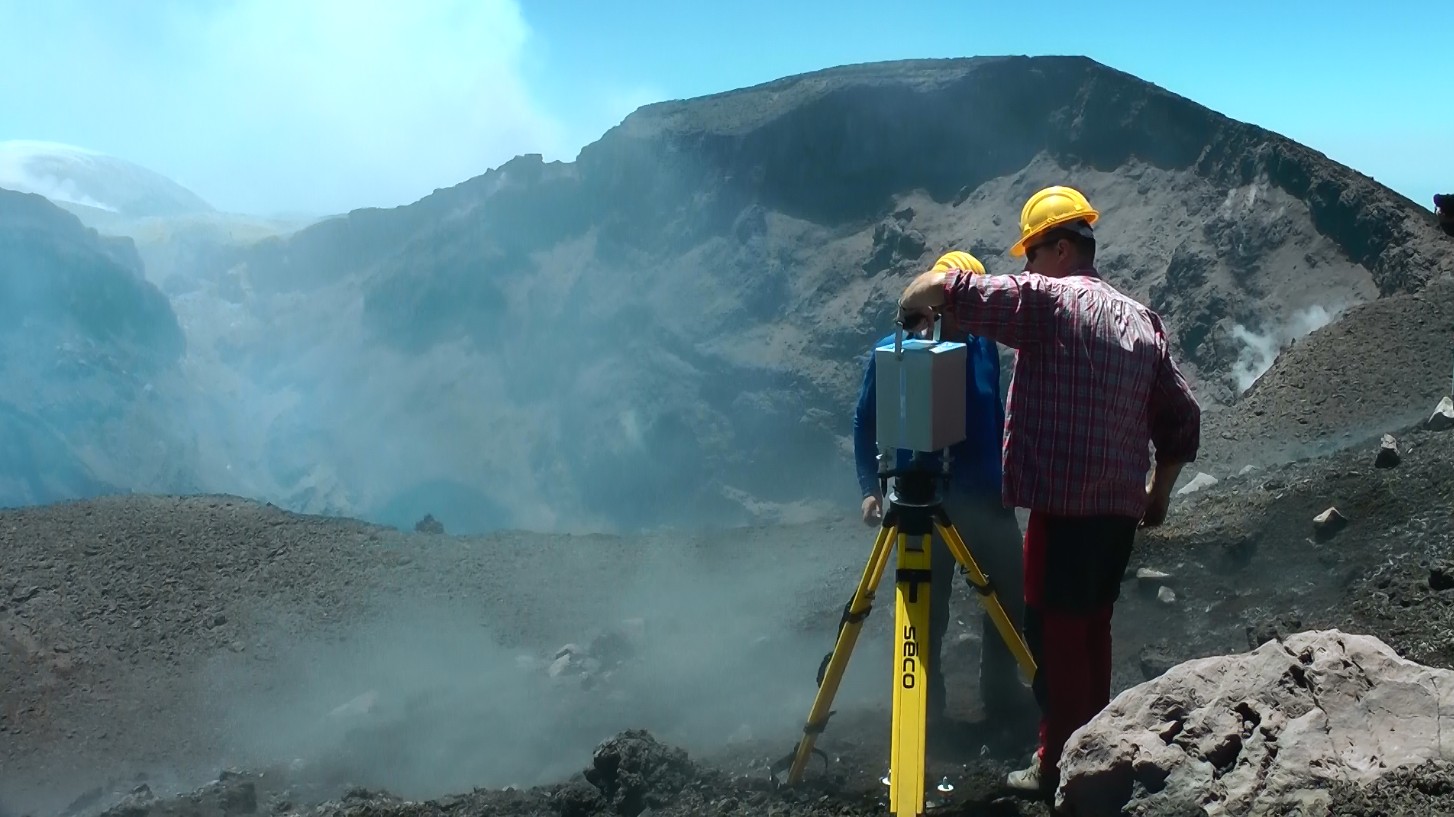
Gravimetric measurements at the edge of the NE crater, which exhibited during the day weak strombolian activity deep inside, and occasionally threw out volcanic bombs
To interpret properly the temporal gravity changes observed in volcanic areas, the gravity signal induced by surface deformations (elevation changes) accompanying the process taking place in the guts of a volcano must be removed, so that the residual signal is due to the migration or redistribution of subsurface magma (or its volatiles) that is to be interpreted from the gravity changes. This is standardly done by removing a free-air effect based on theoretical vertical gradient of gravity and a Bouguer effect approximating the attraction of deformed topographic surface. We are proposing a new approach that should be more exact, based on a gradient effect due to a predicted true vertical gradient of gravity (VGG) and an attraction term computed based on numerical Newtonian volumetric integration. Our field work was part of the effort to verify our new approach and to prove it correct and better. For that sake we needed to demonstrate that we can successfully predict the VGG in volcanic areas of prominent rugged topography based on modelling the topographic contribution to the VGG using high resolution high accuracy digital elevation models (DEM) and eventually local improvements using drone-flown photogrammetry.
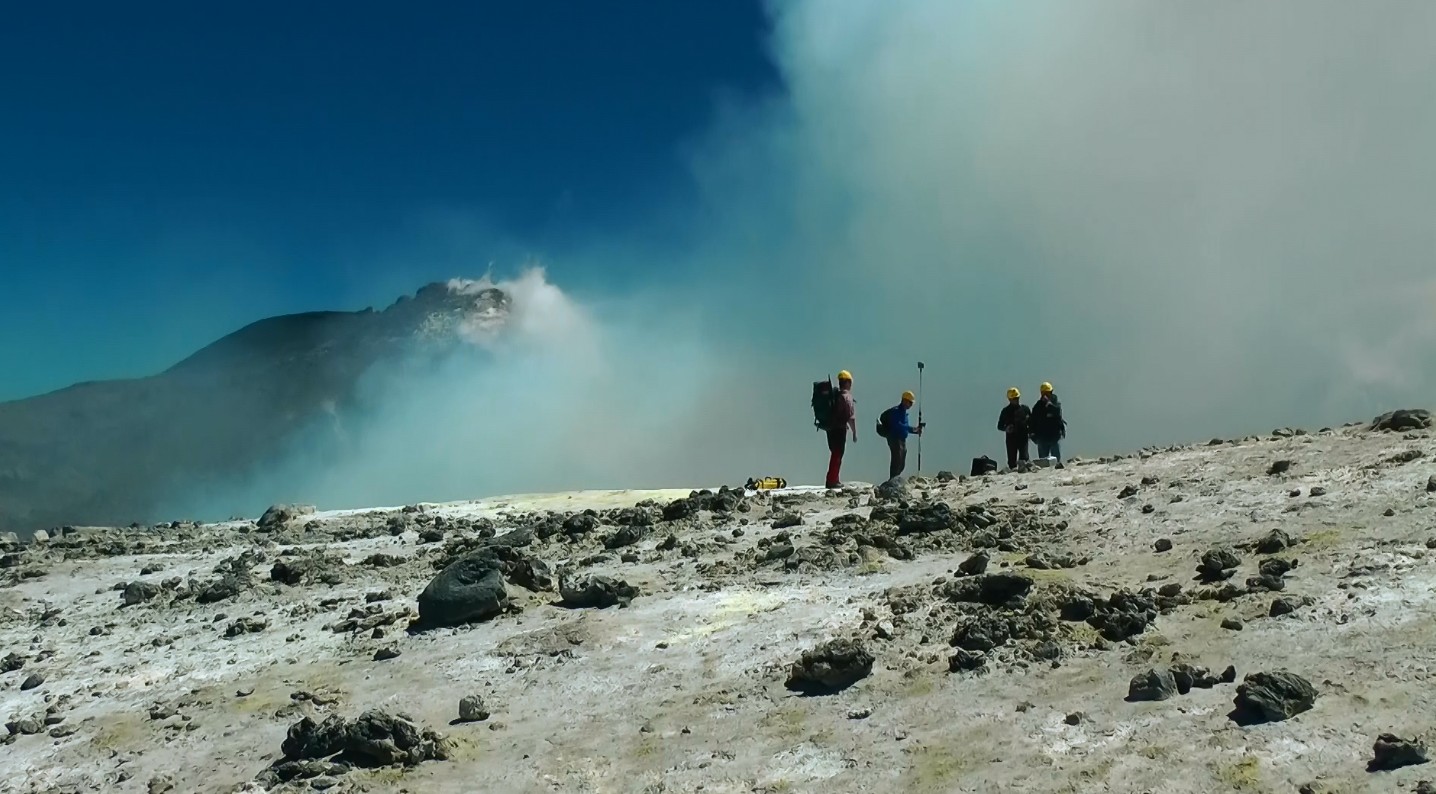
The engagement and the attractive yet demanding worksite environment in the summit craters area
Web resources about Etna and its geophysics and vulcanology:
Combined geodetic and geophysical modelling of a religious edifice
Written by Jaroslava Pánisová | Published in: Microgravimetry |
The implementation of geophysical methods in the monitoring of built heritage offers a valuable, non-destructive insight into the internal structure. We have shown that 2D geophysical images or quantitative interpretations in form of 3D models can be easily incorporated into virtual databases of documented built heritage contributing to the understanding of its historical development also by the public and non-experts. Such multidisciplinary approach to sense the present and past of our historic monuments contributes significantly to their documentation for future generations.
Volcano-Gravimetric observations on Tenerife, 2016
Written by Peter Vajda | Published in: Geodynamics |Researchers from the Earth Science Institute went to Tenerife in June 2016 to carry out volcano-gravimetric field work. The objective of the observation campaign was to measure in-situ vertical gradients of gravity (VGGs) for the sake of verifying the numerically predicted (modelled) extreme values of the VGG. The crew comprised Peter Vajda and Pavol Zahorec of the Department of Gravimetry and Geodynamics of our institute, as well as Juraj Papčo of the Department of Geodesy of the Slovak Technical University in Bratislava. The campaign span one week (20–28 June, 2016). This field work campaign was conducted successfully and the acquired data seem promising.
Polyhedral approximation of buildings in microgravity data processing
Written by Jarka | Published in: Microgravimetry |Microgravity surveys for cavity detection conducted in the interior of buildings require high accuracy during data acquisition and modern processing procedures. We have developed a new method for the calculation of building effects, where geodetic measurements and photogrammetric software PhotoModeler are used. The advantages of the new approach are demonstrated on a small Slovak church, where two crypts were detected using microgravity and GPR methods in summer 2009. We have shown that close-range photogrammetry methods offer a possibility to improve the microgravity data processing.
Geophysical survey of the St. Catherine’s church, Slovakia
Written by Jarka | Published in: Microgravimetry |The ruins of the St. Catherine's monastery complex are an important example of Slovak cultural heritage. An integrated geophysical approach to detect and characterize subsurface archaeological features has been applied in the nave of the former church. The combination of microgravimetry and GPR is shown to be a very effective tool for such mapping. Results from 36 GPR profiles were visualized in the form of horizontal time-slices and vertical time-sections. Several gravity anomalies were found in the residual Bouguer anomaly map. Semi-automated interpretation techniques including the Euler deconvolution and harmonic inversion were used to investigate the depth and shape of anomalous sources.
Integrated lithospheric modelling in the Red Sea area
Written by Jana Dérerová | Published in: Earth Crust and Lithosphere |Radwan A. H. A. 1, Issawy E. A. 1, Dérerová J. 2, Bielik M. 2,3, Kohút I. 2
1National Research Institute of Astronomy and Geophysics
2Geophysical Institute of the Slovak Academy of Sciences
3Department of Applied and Environmental Geophysics, Faculty of Natural Sciences, Comenius University3
Introduction
The Red Sea is considered to be a typical example of a newly formed ocean, therefore, a great number of studies discuss its evolution and development especially in relationship to continental rifting, initiation of sea floor spreading and plate tectonics. We focused on the 2D integrated geophysical modelling with a goal to calculate an original model of the lithospheric structure and lithosphere thickness along Profile 1 (Fig. 1) in the Red Sea region. To know lithospheric structure and thickness is important for geodynamical reconstruction of the area.
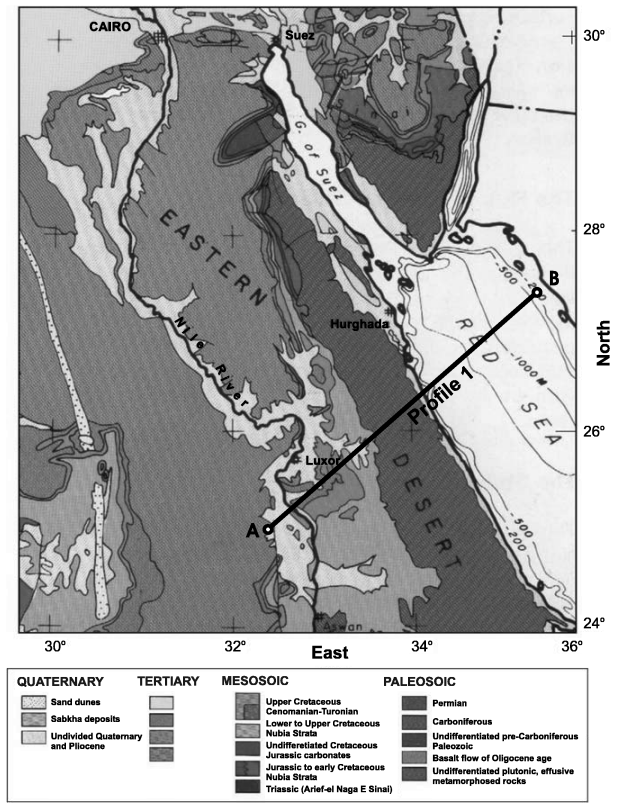
Fig. 1. Surface geological map for the region of study (from EgyptianGeological Survey, 1994) with location of studied profile.

